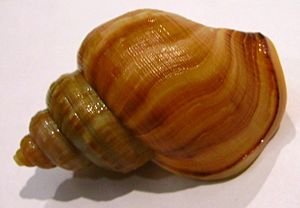Pelicaria facts for kids
Pelicaria is a special kind of sea snail. It's a mollusc that lives in the ocean. You can find these snails as part of the Struthiolariidae family, which is a group of sea snails.
Quick facts for kids Pelicaria |
|
|---|---|
 |
|
| Dorsal view of a shell of Pelicaria vermis | |
| Scientific classification | |
| Kingdom: | |
| Phylum: | |
| Class: | |
| (unranked): |
clade Caenogastropoda
clade Hypsogastropoda clade Littorinimorpha |
| Superfamily: |
Stromboidea
|
| Family: |
Struthiolariidae
|
| Genus: |
Pelicaria
Gray, 1857
|
What is a Sea Snail?
Sea snails are amazing creatures that belong to a large group called gastropods. This group includes all snails and slugs, whether they live in the ocean, on land, or in fresh water. Gastropods are a type of mollusc, which also includes animals like clams, oysters, and octopuses.
Most sea snails, like Pelicaria, have a hard, spiral shell. They carry this shell on their back, and it acts like a protective home. If danger comes, they can pull their soft body inside the shell to stay safe.
The Pelicaria Shell
The shell of a Pelicaria snail is usually shaped like a cone or a spindle. It has a pointed top and gets wider towards the bottom. The shell often has interesting patterns or ridges on its surface. The image in the infobox shows the shell of Pelicaria vermis, which is a good example of what these shells look like.
Different Kinds of Pelicaria
Scientists use the word "species" to talk about different kinds of animals that are very similar and can have babies together. The genus Pelicaria includes several different species. Some of these species are still alive today, while others are only known from fossils.
When you see a small dagger symbol (![]() ) next to a species name, like † Pelicaria arahura, it means that species is extinct. This means it no longer lives on Earth. We only know about them from the fossils they left behind.
) next to a species name, like † Pelicaria arahura, it means that species is extinct. This means it no longer lives on Earth. We only know about them from the fossils they left behind.
Here are some examples of Pelicaria species:
- † Pelicaria arahura
- † Pelicaria canaliculata
- † Pelicaria cestata
- Pelicaria vermis
Sometimes, scientists might give different names to the same species over time. When this happens, the older or less common names become "synonyms." It's like having two different nicknames for the same person. For example, some species that were once called Pelicaria acuminata or Pelicaria convexa are now known to be the same as Pelicaria vermis.

